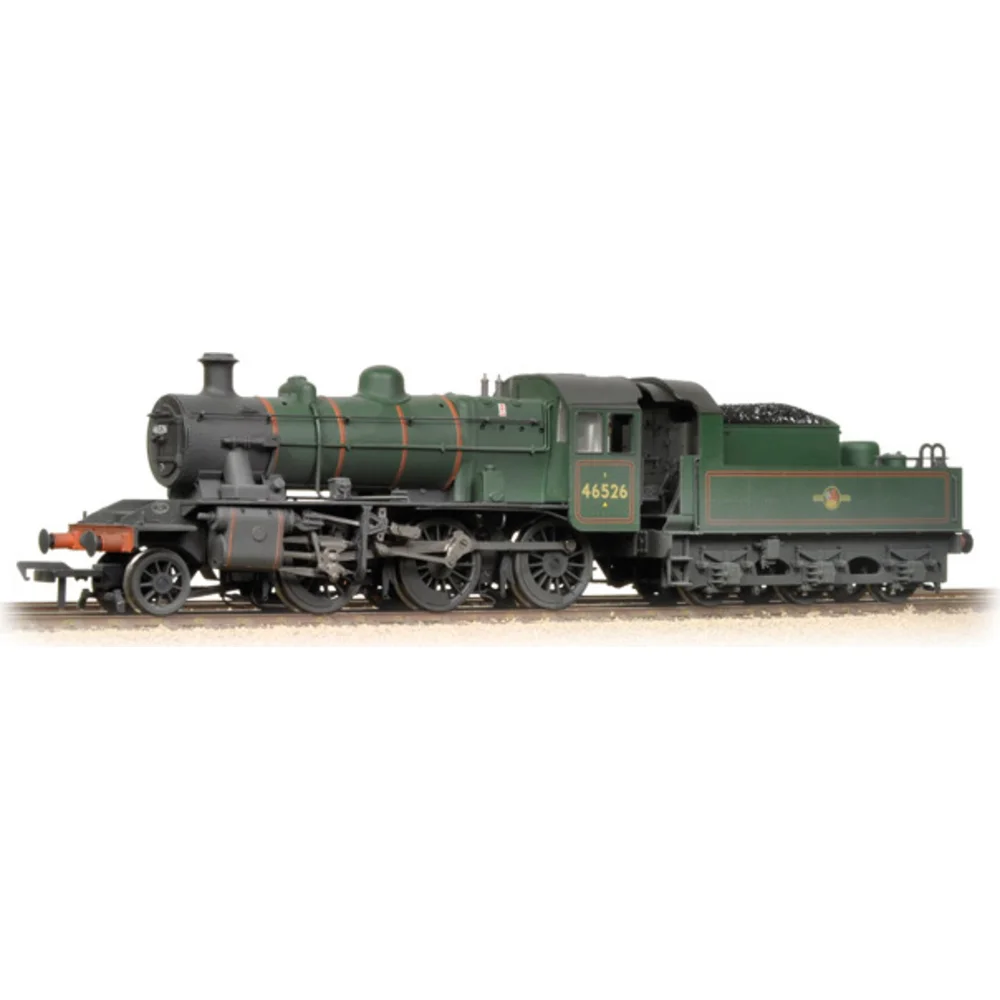Bachmann 32-828A
London, Midland & Scottish Railway Ivatt Class 2 2-6-0 46526 British Railways Lined Green with Late Crest
Tooling
The Bachmann Branchline LMS Ivatt Class 2MT 2-6-0 was first introduced in 2007 as part of Bachmann’s OO gauge range. Designed to represent the post-war mixed-traffic moguls developed by H.G. Ivatt for the LMS, the model filled a gap in the market for a reliable and well-detailed representation of this versatile locomotive class. The tooling has since been used across multiple liveries and configurations, including special editions for the Bachmann Collectors Club.
Tooling Features
- Scale: OO gauge (1:76)
- Construction: Injection-moulded plastic body with separately fitted metal and plastic details
- Detailing: Flush glazing, separately fitted handrails, lamp irons, rivet detail, sprung metal buffers, and fine cab detailing
- Couplings: NEM pockets with tension lock couplings
Mechanical & Electrical
- Motor: Three-pole motor
- Drive: Loco-drive mechanism with drive to centre driving wheels
- Minimum Radius: Second radius curves (approx. 10.5 inches / 260 mm)
- Weighting: Moderate weight for reliable traction; some models include traction tyres
- Lighting: No factory-fitted lighting
DCC Capability
- OO Gauge: DCC Ready with 8-pin socket located in the tender
- Issues: Early OO models lacked tender pickups, affecting electrical reliability
Liveries Produced
- LMS Black
- BR Plain Black
- BR Lined Black (Early & Late Crest)
- BR Lined Green (Early & Late Crest)
- BR Maroon (Preservation-era special)
Reviews & Commentary
- Praised for high-quality detailing and accurate liveries
- Criticised for noisy motor and lack of tender pickups in early releases
- Collectors Club and SOUND FITTED editions received positively for enhanced features
- Social media and YouTube reviews (e.g., Sam’s Trains) highlight visual appeal and running performance
Interesting Notes
- Preserved locomotive No. 46521 featured in the BBC sitcom Oh, Doctor Beeching!
- Brassmasters and other aftermarket suppliers offer chassis kits for finescale conversions
The Bachmann Ivatt Class 2MT tooling remains a popular choice for modellers seeking a reliable and well-detailed representation of this iconic mixed-traffic locomotive. Its continued presence in OO gauge ranges reflects its enduring appeal and versatility.
Class & Prototype
- Class: London, Midland & Scottish Railway Ivatt Class 2 2-6-0
- Traction: Steam
- Built: 1946-1953
- Total Built: 128
- Running Number: 46526
Operator & Livery
- Operator: British Railways
- Livery: Lined Green with Late Crest
- Era: 5 - British Railways Late Crest
British Railways transformed Britain's fragmented rail network into a unified national system following nationalisation on 1st January 1948. Created from the "Big Four" companies under the Transport Act 1947, BR operated most of Great Britain's railways until rebranding as British Rail in 1965, managing over 20,000 route miles and inheriting nearly 20,000 locomotives of diverse designs.
The organisation pioneered standardisation through its revolutionary BR Standard locomotive programme (1951-1960), producing 999 advanced steam engines under Robert Riddles' direction. These included the versatile Britannia Pacifics, mighty 9F freight engines, and mixed-traffic classes that incorporated the best features from all predecessor companies. The 1955 Modernisation Plan accelerated diesel and electric traction development, creating fascinating mixed-traction operations.
Notable achievements included establishing unified locomotive classification systems, introducing distinctive corporate liveries, and managing the complex transition from steam to modern traction. BR's six regional structure preserved operational diversity whilst enabling standardisation of practices, signalling, and rolling stock that had eluded private enterprise for over a century.
The BR era represents steam traction's final flowering alongside emerging diesel technology, creating unparalleled locomotive variety. Today, this heritage remains highly popular with railway enthusiasts through extensive preserved fleets, heritage railway operations, and comprehensive model ranges from manufacturers like Hornby, Bachmann, and Dapol, making BR subjects essential for authentic post-war British railway modelling across all scales.
British Railways' lined green livery continued for express passenger locomotives from 1956, painted in BS224 Deep Bronze Green (also known as Land Rover Deep Bronze Green) with orange and black lining, maintaining the prestigious finish for the railway's premier motive power. The livery was reserved for the most powerful express passenger classes, including Britannias, Castles, Kings, A4s, Merchant Navy Pacifics, and other premier locomotives rated for top-link express duties. From 1954 onwards, green became more widely adopted across the locomotive fleet, with some mixed-traffic engines also receiving the prestigious finish as regional freedom in livery matters increased following the 1953 Transport Act.
From mid-1956, these locomotives received the new "Lion and Crown" emblem (nicknamed the "Ferret and Dartboard"), a proper heraldic device registered with the College of Arms featuring a rampant lion emerging from a crown and holding a spoked wheel, all enclosed in a roundel with "British Railways" on bars either side. The emblem was positioned centrally on tender sides, with the heraldically correct lion facing left, though some locomotives initially received forward-facing applications during the transition period. Lettering and numbering remained in golden yellow Gill Sans Medium, maintaining the high-quality finish appropriate for express passenger duties. Regional variations in the shade of green occurred depending on which works applied the paint, the suppliers used, and the number of paint layers applied, creating subtle differences between locomotive classes and individual engines. This livery represented the final flowering of BR's steam-era corporate identity, combining technical excellence with heraldic dignity during the twilight years of express steam operations before the Rail Blue revolution of the mid-1960s.
